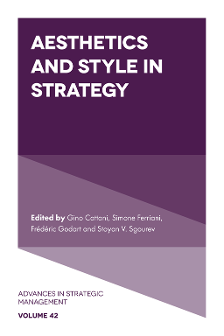
Index
Aesthetics and Style in Strategy
ISBN: 978-1-80043-237-6, eISBN: 978-1-80043-236-9
ISSN: 0742-3322
Publication date: 9 November 2020
Citation
(2020), "Index", Cattani, G., Ferriani, S., Godart, F. and Sgourev, S.V. (Ed.) Aesthetics and Style in Strategy (Advances in Strategic Management, Vol. 42), Emerald Publishing Limited, Leeds, pp. 275-279. https://doi.org/10.1108/S0742-332220200000042010
Publisher
:Emerald Publishing Limited
Copyright © 2021 Emerald Publishing Limited.
INDEX
- Prelims
- The Aesthetic Turn in Strategy: Creating Value with Style
- Part I Stylistic Production
- Style Typologies and Competitive Advantage
- Aesthetic and Technological Complexity in Luxury Watchmaking
- From Style to Status and to Power: When and Why Do Stylistic Choices in Footwear Make Women Feel and Act Powerful?
- Content or Connections? Socio-Semantic Analysis of Leaders' Communication Styles in a Creative Collective
- Tell Me Your Story and I Will Tell Your Sales: A Topic Model Analysis of Narrative Style and Firm Performance on Etsy
- Part II Stylistic Evaluation
- A Rising Tide Lifts all Boats: The Origins of Institutionalized Aesthetic Innovation
- Changing Style in Style-changing Industries: The Role of Critics as Gatekeepers in High-end Fashion
- Does Stylistic Similarity to Popular Competitors Affect Consumer Evaluations of Quality? Evidence from Online Movie Evaluations
- Strategic Balance or Imperfect Imitation? Style and Legitimation Challenges in a Semi-peripheral City
- Part III Reflections on Style
- Reflections on Style and Strategy: An Interview with Candace Jones
- Reflections on Style and Strategy: An Interview with Gianni Lorenzoni
- Reflections on Style and Strategy: An Interview with Virginia Postrel
- Reflections on Style and Strategy: An Interview with Davide Ravasi
- Reflections on Style and Strategy: An Interview with Antonio Strati
- Index